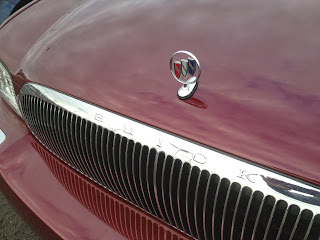Years of Northeast Ohio road brine have done a job on the plastic centers of these handsome alloy rims
There isn't a bad line on the '93-'97 Camaros. GM mucked up the design for 1998 trying to freshen it up
The styling was to die for and still holds up well (gulp) twenty years after it debuted. To get the swoopy, almost Corvette like curves, GM used polymer (plastic) exterior panels similar to what they used on Saturn's. These plastic panels (not to be confused with the fiberglass body used on Corvettes) don't dent but they do scratch, bend, crack and ultimately can break. There's also some shift that goes on as these cars age. The hood, fascia and front fenders of our subject are out of alignment. Finally, there's the added weight of a full frame to help support all those plastic panels. The plastic body made for some neat architecture in lieu of any weight savings. All that weight tends to deaden the performance of the 160 horsepower, 3.4 liter V-6 engine. Upside, you don't want teenagers having anything they could be competitive with in a drag race.
"Camaro" allegedly means "friend" in French. Will you be my friend?
There's some serious bulk to this car; it feels huge. Not that it isn't but it does feel larger than it actually is. You sit low, real low in this thing; like you're sitting in a tall bathtub. Also, not being able to see any part of the hood when you're down there in the hole adds to the feeling the car is gigantic. Gigantic and dense while at the same time cramped inside.
The front passenger seating further compromised by a huge catalytic converter hump. There's no way to sit comfortably in the passenger seat of an '82-'02 F-body because the floor is pushed upwards towards the back of your legs. The back seat? Oh, you mean the parcel shelf that looks like a seat? When I had one of these (a 2002 Z-28), our boys, 8 and 9 at the time, referred to that back seat as "The Cave".
Torture chamber
The front passenger seating further compromised by a huge catalytic converter hump. There's no way to sit comfortably in the passenger seat of an '82-'02 F-body because the floor is pushed upwards towards the back of your legs. The back seat? Oh, you mean the parcel shelf that looks like a seat? When I had one of these (a 2002 Z-28), our boys, 8 and 9 at the time, referred to that back seat as "The Cave".
My boys hated this car. Now they wish I still had it
I don't know if its me getting older or just mellowing out in general but I much prefer these "lesser" models of sporty cars than their top of the line, full on sport models. This car is a pleasant driver with a compliant ride, ample handling and decent enough power. The brakes have some ABS issues (alarming), she pulls to the right and the driver's door is a hot mess. The window doesn't roll up or down, the power lock switch is busted and the handle doesn't work so you can't get out. Oye!
In comparison, my Z-28 was an obnoxious, unapologetic punk of a car whose punishing ride made me regret buying it at every turn. Now, the 310 horsepower, 5.7 liter my Z-28 had? Put that in this and you have "my car". Sorry, no dice. Never an option.
Despite our teenage boys protests, my up selling a rear wheel drive "sports car" along with the several weekends of projects to get it up to snuff was long putt for me to make with my wife.
The search continues!
Hey good lookin'! Care to bust up my spine into a million tiny bits?
In comparison, my Z-28 was an obnoxious, unapologetic punk of a car whose punishing ride made me regret buying it at every turn. Now, the 310 horsepower, 5.7 liter my Z-28 had? Put that in this and you have "my car". Sorry, no dice. Never an option.
The base model of these cars is a much better daily driver than the Z-28
Despite our teenage boys protests, my up selling a rear wheel drive "sports car" along with the several weekends of projects to get it up to snuff was long putt for me to make with my wife.
The search continues!
I love you. But no.
















































